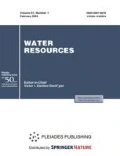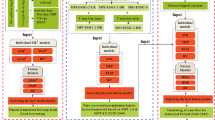Abstract
The probable maximum precipitation which is defined as the maximum precipitation at a particular location for a given duration is used as a design criterion for major dams. The assumptions of deterministic consideration and an upper limit to probable maximum precipitation have been repeatedly criticized by hydrologists. Nowadays, multifractal method which strongly contains physical bases can be used to improve the probable maximum precipitation. In this research, the universal multifractal model was used to estimate the design probable maximum precipitation for specified exceedence probability in basin of Bakhtiari Dam, southwest Iran, and its results were compared with statistical and synoptically methods. The results revealed that the return period of statistical and synoptically probable maximum precipitation, estimated for the different durations, are about 109 and 103–104 years, respectively; also, over periods ranging from 1 to 7 days, the ratios of design probable maximum precipitations, estimated based on multifractal method for return period of 103–109 years, to statistical and synoptically probable maximum precipitation estimates ranged from 0.61 to 1.1 and 1.33 to 2.37, respectively. These results indicated that the multifractal method can be used to reasonably estimate the probable maximum precipitation.
Similar content being viewed by others
References
Bara, M., Analysis of Short-Term Rainfall Intensities the Simple Scaling Approach, 20th Conference of Young Hydrologists, CD, Bratislava: SHMI, 2008.
Bara, M., Scaling Properties of Extreme Rainfall in Slovakia, 11th International Science Conference of PhD Student, CD. Brno: Juniorstav VUT, 2009.
Benson, M.A., Thoughts on the Design of Design Floods, in Floods and Droughts. 2nd International Symposium of Hydrology, Fort Collins: Water Res. Pub., 1973. pp. 27–33.
Burlando, P., and Rosso R. Scaling and Multiscaling Models of Depth-Duration-Frequency Curves for Storm Precipitation, J. of Hydrology, 1996, vol. 187, pp. 45–64.
De Lima, M.I.P., and Grasman, J., Multifractal Analysis of 15-min and Daily Rainfall from a Semi-Arid Region in Portugal, J. of Hydrology, 1999, vol. 220, pp. 1–11.
Dooge, J.C.I., Looking for Hydrologic Laws, Water Resources Research, 1986, vol. 22, pp. 46–58.
Douglas, E.M., Barros, A.P., Probable Maximum Precipitation Estimation Using Multifractals: Application in the Eastern United States, J. of Hydrometeorology, 2003, no. 4, pp. 1012–1024.
Fontaine, T.A., and Potter, K.W., Estimating Probabilities of Extreme Rainfalls, J. of Hydrology Engineering, ASCE, 1989, vol. 115, no. 11, pp. 1562–1575.
Hershfield, D.M,. Estimating the Probable Maximum Precipitation, J. of Hydraulic., 1961, vol. 87, pp. 99–106.
Hershfield, D.M., Method for estimating probable maximum precipitation, J. of American Water Works Association, 1965, vol. 57, pp. 965–972.
Hubert, P., Tessier, Y., Lovejoy, S., et al., Multifractals and Extreme Rainfall Events, Geophysical Research Letters, 1993, vol. 20, pp. 931–934.
Kiely, G., and Ivanova, K., Multifractal Analysis of Hourly Precipitation, Physic, Chemistry and Earth, 1999. vol. 24, no. 7, Pt. B, pp. 781–786.
Koutsoyiannis, D., A Probabilistic View of Hershfield’s Method for Estimating Probable Maximum Precipitation, Water Res., 1999, no. 3, pp. 1313–1322.
Labat, D., Mangin, A., and Ababou, R., Rainfall-Runoff Relations for Karstic Springs: Multifractal Analysis, J. of Hydrology, 2002. vol. 256, pp. 176–195.
Lavallee, D., Schertzer, D., and Lovejoy, S., On the Determination of the Codimension Function, Non-Linear Variability in Geophysics, Schertzer, D., and Lovejoy, S., Eds., Dordrecht: Kluwer Academic Publ., 1991, pp. 99–109.
Lovejoy, S., and Schertzer, D., Generalized Scale Invariance and Fractal Models of Rain, Water Resources Research, 1985, vol. 21, pp. 233–1250.
Lovejoy, S., and Schertzer, D., Multifractals and Rain. New Uncertainty Concepts in Hydrology and Water Resources, Cambridge: Cambridge University Press, 1995, pp. 61–103.
National Research Council Estimating Bounds on Extreme Precipitation Events, Washington: National Academy Press, 1994.
Over, T.M., and Gupta, V.K., Statistical Analysis of Mesoscale Rainfall: Dependence of Random Cascade Generator on Large-Scale Forcing, J. of Applied Meteorology, 1994, vol. 33, pp. 1526–1542.
Pandey, G., Lovejoy, S., and Schertzer, D., Multifractal Analysis of Daily River Flows Including Extremes for Basins of Five to Two Million Square Kilometers, one Day to 75 Years, J. of Hydrology, 1998, vol. 208, pp. 62–81.
Papalexiou, S., and Koutsoyiannis, D., A Probabilistic Approach to the Concept of Probable Maximum Precipitation, Advances in Geosciences, 2006, no. 7, pp. 51–54.
Pathirana, A., Herath, S., and Yamada, T., Estimating Rainfall Distributions at High Temporal Resolutions Using a Multifractal Model, Hydrology and Earth Sciences, 2003, vol. 7, no. 5, pp. 668–679.
Royer, J., Biaou, A., Chauvin, F., et al., Multifractal Analysis of the Evolution of Simulated Precipitation over France in a Climate Scenario, C. R. Geoscience, 340, 2008, pp. 431–440.
Schertzer, D., and Lovejoy, S., Physical Modeling and Analysis of Rain and Clouds by Anisotropic Scaling Multiplicative Processes, J. of Geophysical Res., 1987, vol. 92, pp. 9693–9714.
Schertzer, D., and Lovejoy, S., Multifractal Simulations and Analysis of Clouds by Multiplicative Processes, Atmospheric Research, 1988, vol. 21, pp. 337–361.
Schertzer, D., and Lovejoy, S., Nonlinear Variability in Geophysics, Fractals: Physical Origins and Properties, Pietronero L., Ed., N. Y.: Plenum Press, 1989. pp. 49–79.
Schertzer, D., and Lovejoy, S., Non-Linear Variability in Geophysics, Dordrecht: Kluwer Academic Publ., 1991.
Sivakumar, B., Fractal Analysis of Rainfall Observed in Two Different Climatic Regions, Hydrological Sciences, 2000, vol. 45, no. 5, pp. 727–738.
Tessier, Y., Lovejoy, S., and Hubert, P., et al., Multifractal Analysis and Modeling of Rainfall and River Flows and Scaling, Casual Transfer Function, J. of Geographic Res., 1996, vol. 101, pp. 26427–26440.
Veneziano, D., Lepore, C., Langousis, A., and Furcolo, P. Marginal Methods of Intensity-Duration-Frequency Estimation in Scaling and Nonscaling Rainfall, J. Water Res., 2007, vol. 43, W10418. doi: 10410.11029/12007WR006040
Veneziano, D., Bras, R.L., and Niemann, J.D., Nonlinearity and Self-Similarity of Rainfall in Time and a Stochastic Model, J. of Geophysics Res., 1996, vol. 101, pp. 27371–26392.
WMO Manual for Estimation of Probable Maximum Precipitation. Operational hydrology, 1986, Rep. 1, WMO-No. 332.
Author information
Authors and Affiliations
Corresponding author
Additional information
The article is published in the original.
Rights and permissions
About this article
Cite this article
Gheidari, M.H.N., Telvari, A., Babazadeh, H. et al. Estimating design probable maximum precipitation using multifractal methods and comparison with statistical and synoptically methods case study: Basin of Bakhtiari Dam. Water Resour 38, 484–493 (2011). https://doi.org/10.1134/S0097807811040105
Received:
Published:
Issue Date:
DOI: https://doi.org/10.1134/S0097807811040105




